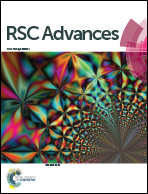A mechanistic approach for superoxide radicals and singlet oxygen mediated enhanced photocatalytic dye degradation by selenium doped ZnS nanoparticles
Abstract
Structural modification of semiconductor type nanoparticles by doping with metals and non-metals renders versatility of the material. Here, we report the synthesis of <4 nm sized nanocrystalline selenium doping in ZnS nanoparticles (Se-doped ZnS NPs) by chemical precipitation method, and discuss the mechanism involved in drastic improvement in its photocatalytic activity as compared to pristine ZnS nanoparticles. An array of characterization techniques, including X-ray diffraction (XRD), high-resolution transmission electron microscopy (HRTEM), diffuse reflectance spectroscopy (DRS), Fourier-transform infrared spectroscopy (FT-IR), zeta potential and BET surface area measurements were performed to confirm the synthesis of stable Se-doped ZnS NPs with large surface area. Selenium doping not only led to lattice distortion in the ZnS lattice but it also resulted in band gap narrowing due to incorporation of defect sites within the forbidden gap, supported by fluorescence emission spectroscopy studies. These modified properties in Se-doped ZnS NPs were important for enhanced sunlight induced photocatalytic activity, demonstrated via degradation of trypan blue dye. Compared to the pristine ZnS nanoparticles, the kinetic study revealed a three-fold increase in the efficiency of the dye degradation and about seven-fold increase in the rate of dye degradation by Se-doped ZnS NPs. The mechanism of the dye degradation is studied in terms of scavenging of generated reactive oxygen species (ROS) in the reaction medium. The p-benzoquinone and sodium azide assay confirmed that the dye degradation by Se-doped ZnS was due to production of superoxide radicals and singlet oxygen species, respectively, which were generated due to interaction of photoexcited conduction band electrons with molecular oxygen at the surface of the nanoparticles. The proposed mechanism is supported by the theoretical calculation of the band structure of Se-doped ZnS nanoparticles.


 Please wait while we load your content...
Please wait while we load your content...